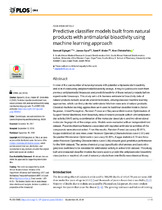| dc.contributor.author | Egieyeh, Samuel | |
| dc.contributor.author | Syce, James | |
| dc.contributor.author | Malan, Sarel F. | |
| dc.contributor.author | Christoffels, Alan | |
| dc.date.accessioned | 2018-10-10T07:50:33Z | |
| dc.date.available | 2018-10-10T07:50:33Z | |
| dc.date.issued | 2018 | |
| dc.identifier.citation | Egieyeh, S. (2018). Predictive classifier models built from natural products with antimalarial bioactivity using machine learning approach. PLoS ONE, 13(9): e0204644. | en_US |
| dc.identifier.uri | https://doi.org/10.1371/journal. pone.0204644 | |
| dc.identifier.uri | http://hdl.handle.net/10566/4097 | |
| dc.description.abstract | In view of the vast number of natural products with potential antiplasmodial bioactivity
and cost of conducting antiplasmodial bioactivity assays, it may be judicious to learn from
previous antiplasmodial bioassays and predict bioactivity of these natural products before
experimental bioassays. This study set out to harness antimalarial bioactivity data of
natural products to build accurate predictive models, utilizing classical machine learning
approaches, which can find potential antimalarial hits from new sets of natural products.
Classical machine learning approaches were used to build four classifier models (Naïve
Bayesian, Voted Perceptron, Random Forest and Sequence Minimization Optimization of
Support Vector Machines) from bioactivity data of natural products with in-vitro antiplasmodial
activity (NAA) using a combination of the molecular descriptors and two-dimensional
molecular fingerprints of the compounds. Models were evaluated with an independent test
dataset. Possible chemical features associated with reported antimalarial activities of the
compounds were also extracted. From the results, Random Forest (accuracy 82.81%,
Kappa statistics 0.65 and Area under Receiver Operating Characteristics curve 0.91) and
Sequential Minimization Optimization (accuracy 85.93%, Kappa statistics 0.72 and Area
under Receiver Operating Characteristics curve 0.86) showed good predictive performance
for the NAA dataset. The amine chemical group (specifically alkyl amines and basic nitrogen)
was confirmed to be essential for antimalarial activity in active NAA dataset. This study
built and evaluated classifier models that were used to predict the antiplasmodial bioactivity
class (active or inactive) of a set of natural products from interBioScreen chemical library. | en_US |
| dc.language.iso | en | en_US |
| dc.publisher | Public Library of Science | en_US |
| dc.rights | © 2018 Egieyeh et al. This is an open
access article distributed under the terms of the
Creative Commons Attribution License, which
permits unrestricted use, distribution, and
reproduction in any medium, provided the original
author and source are credited. | |
| dc.subject | Antiplasmodial bioactivity assays | en_US |
| dc.subject | Predict bioactivity | en_US |
| dc.subject | Natural products | en_US |
| dc.subject | Antimalarial bioactivity data | en_US |
| dc.title | Predictive classifier models built from natural products with antimalarial bioactivity using machine learning approach | en_US |
| dc.type | Article | en_US |
| dc.privacy.showsubmitter | FALSE | |
| dc.status.ispeerreviewed | TRUE | |

